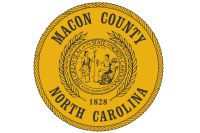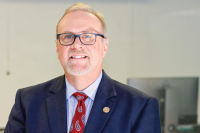The Creative Thought Center: For many, the final step on a spiritual journey
 The front wall of the Creative Thought Center sanctuary is decorated with a landscape mural. Kim Walzer photo
The front wall of the Creative Thought Center sanctuary is decorated with a landscape mural. Kim Walzer photo
On Sunday morning, silence falls in the Creative Thought Center, save the voice of Kim May as she leads her congregation through a meditation. This week she’s brought in a pad of sticky notes for each member containing 16 different affirmations. Members are directed to flip to one at random and ruminate on the affirmation during meditation.
I flip to a page that says “I am where I am and that’s OK. I know how to get to where I want to be. I reach for relief.”
The Creative Thought Center is an interfaith community in Waynesville. The core of its teaching is based in “The Science of Mind,” a work by New Thought writer, teacher and leader Ernest Holmes (1887-1960). However, The Creative Thought center explores the truths they see permeating many of the world’s great spiritual traditions. The bottom line? “We embrace all philosophies that do not cause harm to others or the earth.”
Ernest Holmes wrote “The Science of Mind” in 1926. In the book, Holmes explores his belief that God is a never-ending energy source that is present throughout the universe and in all beings. Through prayer, Holmes believed that people can connect with God and heal spiritual, mental and physical wounds.
“God is not ... a person, but a Universal Presence ... already in our own soul, already operating through our own consciousness,” said Holmes.
Related Items
Holmes’ ideas can be understood through the lens of the New Thought Movement, a philosophical school that emerged during the 19th Century which sought to connect science, philosophy and religion.
Though “The Science of Mind” is essentially religious theory, Holmes didn’t initially intend for the book to spur a religious denomination. After its publication in 1927, Holmes established the Institute of Religious Science and Philosophy in Los Angeles. However, it wasn’t until 1949 that he reluctantly agreed to the creation of a Religious Science denomination. There are now two branches of Religious Science — The United Church of Religious Science and Religious Science International.
One important tenet of Religious Science is the idea that all people are incarnations of God, or the spirit, or the universal force. In this sense, God is a self-knowing power. By recognizing the divine within oneself, people can draw on its infinite resources through affirmative prayer. Spiritual mind treatment or affirmative prayer is a form of prayer intended to clear thoughts of negation, doubt and fear, and instead perceive the ever-presence of God within oneself.

Following Sunday morning’s meditation, there is time for fellowship. In addition to its sanctuary, the Creative Thought Center has a kitchen area with a long, community table. Between meditation and the start of Sunday service, members can be found drinking tea and coffee and chatting with their community.
“There is the atmosphere of unconditional love,” said Practitioner Joan Doyle.
Acceptance is huge for members at the center. They are committed to welcoming all people, regardless of sexual orientation, age, faith history or anything else.
“It saddens me that we have to list that because I feel like that should just be a given,” said Doyle. “But we have to list the things that divide us. My vision is that we don’t use those words anymore. We don’t have to list.”
The center does not currently have a minister, but four of its members are practitioners — members of the congregation trained to guide services and administer Spiritual Mind Treatment — with another member currently undergoing training to become a practitioner.
The service that unfolds is one that any Christian church-goer would recognize. First, the practitioner welcomes everyone and leads the congregation in prayer, then song. Then, a practitioner will give the equivalent of a sermon, or a homily. On Sunday, the speaker explored her path in faith from being raised Presbyterian to eventually finding Religious Science, with many stops in several different denominations and faith organizations along the way.
“There is a thread of truth that runs through all religious teachings,” she said.
This journey from other faiths to Religious Science is not unique among members at the creative thought center. Both Kim Walzer, President of the Board of Trustees of the center, and Joan Doyle, board trustee and practitioner, were born and raised in Catholic families. Eventually, both women found themselves ill at ease with the Catholic church.
“To me it felt very divisive,” said Walzer. “It was separating me from people instead of giving me an opportunity to explore my own spirituality and how I was supposed to move through the world.”
“I grew up in Ireland, I went to convent school, boarding school, all of that,” said Joan Doyle. “But about 18, I was like, this is just not my idea of God. My idea of God is so broad and it encompasses everybody. And to say ‘we are the right religion’ was, in my heart and soul, just wrong. I see God as just all-encompassing and loving every individual in whatever way he can show up. And how could somebody born in India not get into heaven just because they were of a different faith? It was just wrong to me.”
Both these women found Religious Science once they began to look for a deeper spiritual experience. Doyle, as she explored churches while living in Los Angeles, and Walzer after a traumatic change forced her and her husband to uproot their lives and move to Western North Carolina. She happened upon the Creative Thought Center while on a walk one day and knew immediately that it was the place for her.
“There is an energy with the center,” said Walzer. “I was looking for something different that was actually going to give me some practical tools to live my life instead of rules and regulations that I didn’t think I fit into anymore. I feel like I was instantly transformed within a couple months of coming there.”
Since finding the center, Walzer has had the chance to be on the other side of the door when people discover the Creative Thought Center for the first time. She often hears the phrase, “this is exactly what I was looking for.”

The symbol of Religious Science is painted on the rear wall of the Creative Thought Center sanctuary, surrounded by the symbols of religions from around the world. Kim Walzer photo
The Creative Though Center began in the living room of Reverend Trish Mackey in 1999. She had convened a book club to delve into “The Science of Mind.” Eventually the group got so large that they could no longer convene in the living room, and in 2000 the group obtained their own building. That same year they drew up a charter and became affiliated with Religious Science International.
“Science of Mind is a religious philosophy, a spiritual philosophy, not necessarily a religion with stagnant belief systems that don’t grow and change,” said Walzer. “We are welcoming of everybody. There are books by Dr. Ernest Holmes, which guide us, but we don’t have a stagnant book that says you have to believe this or you can’t belong. And I think that openness has just allowed it to continue to grow.”
In 2012 the Creative Thought Center became an independent Science of Mind organization instead of affiliating with Religious Science International, a move that allowed the center to grow the way members wanted.
The group continues to grow, if slowly, but looks forward to new faces walking through its doors. The current sanctuary can fit upwards of 80 people.
Unlike many faiths, evangelism is not a tenet of Religious Science. Centers and practitioners are ready and waiting to welcome new members and explore their spiritual journey but will not try and convince otherwise content beings to walk the path of Religious Science.
“Our mission is to provide spiritual tools for personal growth and transformation,” said Walzer. “Our purpose is to support individuals on their journey of self discovery. And our vision is to realize a world where all life thrives. Each one of those really encompasses the individual, instead of the ideal. We could be like many of the mainstream religions and say, ‘this is what science of mind means. This is what it represents. How do you fit into that?’ But instead we say, ‘we are here with a spiritual philosophy that works for us. How can we support you?’ So it’s kind of a different way than a lot of religions. Our job is not to transform people from who they are, to what we want them to be.”
The Creative Thought Center does operate a thrift store next to the center on Pigeon Street. This outlet helps to support the center and get involved with causes in the community. The center also hosts several group meetings throughout the week on different topics. There is a Law of Attraction group, women’s groups, men’s groups, as well as a weekly Course in Miracles.
“It’s all about really looking at our thoughts and our beliefs and asking, ‘how are we limiting ourselves?’” said Doyle.













